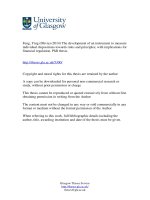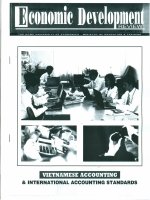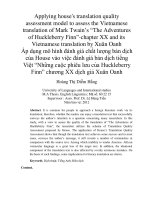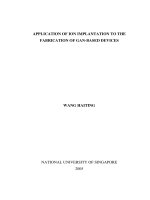The application of altmans z model to measure default risk of the vietnamese commercial banks borrowers
Bạn đang xem bản rút gọn của tài liệu. Xem và tải ngay bản đầy đủ của tài liệu tại đây (572.24 KB, 74 trang )
MINISTRY OF EDUCATION AND TRAINING
UNIVERSITY OF ECONOMICS- HOCHIMINH CITY
Trần Thị Kim Dung
THE APPLICATION OF ALTMAN’S Z’ MODEL TO
MEASURE DEFAULT RISK OF THE VIETNAMESE
COMMERCIAL BANKS’ BORROWERS
MASTER’S THESIS
In
Finance- Banking
Ology Code: 60.31.12
Academic supervisor
Pr.Dr. Trần Ngọc Thơ
Ho Chi Minh City- 2010
ACKNOWLEDGEMENT
I would like to express my sincere gratitude and deep appreciation to my
research Supervisor, Pro. Dr. Tran Ngoc Tho for his precious guidance, share of
experience, ceaseless encouragement and highly valuable suggestions throughout
the course of my thesis.
I would like to thank many of my friends from The state bank of VietnamDong nai branch, Vietcombank and Techcombank, who have helped me during the
collection of data as well as support me during doing the research.
I also would like to take this opportunity to express my appreciation to
Professor Nguyen Dong Phong, UEH Board of Directors for creating MBA
program in English and Dr. Vo Xuan Vinh, Dr. Tran Dinh Kien for his support
during the course.
Specially, my thanks go to Mr Quyet, Mr Trung for their valuable and
enthusiastic support for this research study and for their comments of English from
early draft of my thesis.
Last but not least, the deepest and most sincere gratitude goes to my beloved
parents, my brothers for their boundless support and encouragement throughout my
period of study. I, therefore, dedicate this work as a gift to them all.
i
ABSTRACT
The bankruptcy of a series of large and long- standing banks in the United
States has created an alarming signal to the Vietnamese commercial banks,
especially in the context of existing too many banks combining with over- expanded
credit growth in recent years.
The objective of the thesis is to introduce an intenal model for banks which
will improve their current predictive power of financial risk factors. The thesis aims
at validating the efficiency of Altman z’ score model for credit risk evaluation
through emphirical data. Besides that, a simple and reliable defaulted prediction
model for manufacturing and privately held firms is also developed on the basis of
gathering variables from many models developed in developing countries. Financial
profiles of 48 defaulted and healthy companies are examined and a model is built
using the Discriminant analysis technique. The model can be used as a part of
intenal credit rating in commercial banks. It is also used to assist investors,
creditors, auditors to predict business failure.
Key word: Altman’s model, default risk, bankruptcy risk
ii
TABLE OF CONTENTS
Acknowledgement…………………………………………………………………...i
Abstract……………………………………………………………………………...ii
Table of contents……………………………………………………………………iii
List of figures………………………………………………………………………..v
CHAPTER ONE: INTRODUCTIONi
1.1
Introduction.............................................................................................1
1.2
Research background .............................................................................4
1.3
Research problem....................................................................................9
1.3.1
Research questions.........................................................................11
1.3.2
Research objectives ........................................................................11
1.4
Research method ...................................................................................12
1.5
Data analysis and findings ....................................................................12
1.6
Significance and scope of the study ......................................................13
1.7
Structure of the study ...........................................................................13
CHAPTER TWO: LITERATURES REVIEW..................................................15
2.1
Overview of the Vietnamese banking system.......................................15
2.2
Credit risk..............................................................................................16
2.2.1 Causes...................................................................................................16
2.2.1.1 Macro factors ................................................................................16
2.2.1.2 Customers......................................................................................17
2.2.1.3 Banks .............................................................................................18
2.2.2 Credit risk management......................................................................18
2.3
Overview of Altman’s model ................................................................20
2.3.1
The Z’ model ..................................................................................24
2.3.2
Previous studies..............................................................................27
CHAPTER 3: METHODOLOGY & DATA ANALYSIS ................................35
3.1
Research design .....................................................................................35
iii
3.2
Item generation .....................................................................................36
3.3
Pilot test .................................................................................................37
3.4
Main study.............................................................................................37
3.4.1
Bank selection.................................................................................37
3.4.2
Sampling .........................................................................................43
3.5
Description of sample............................................................................43
3.6
Results of discriminant analysis ...........................................................47
3.7
New points and limitation .....................................................................54
3.7.1
New points ......................................................................................54
3.7.2
Limitations .....................................................................................55
CHAPTER 4: CONCLUSIONS AND IMPLICATIONS ..................................57
4.1
Conclusions related to the research question.......................................57
4.2
Implications of the study.......................................................................58
4.2.1
Theoretical implications..................................................................58
4.2.2
Implications for banks and practitioners ........................................58
4.3
Limitations and recommendations for further research.....................59
iv
LIST OF FIGURES
Figure 1.1- Export- Import during the period of 1986- 2008...................................5
Figure 1.2- GDP growth- Inflation during the period of 1986- 2008.......................5
Figure 1.3- Exchange rate USD/VND in the year of 2008.......................................6
Figure 1.4- Research problem.................................................................................11
Figure 3.1- Research process..................................................................................36
Figure 3.2- The number of banks’ branches in Dong nai province........................38
Figure 3.3- VCB DN’s outstanding structure in 2009............................................40
Figure 3.4- Loan portfolio…………………………..............................................42
LIST OF TABLES
Table 2.1- Vietnamese banking system .................................................................15
Table 2.2- The summary of Altman’s models........................................................24
Table 3.1- The business result of VCB DN from 2002- 2009................................40
Table 3.2- Bad debt (group 3- 5) of VCB DN from 2005 – 2009..........................41
Table 3.3- The summary of classification points of z’ score model.......................45
Table 3.4- Categorization of companies based on industry....................................46
Table 3.5- Categorization of companies based on total assets...............................46
Table 3.6- Group statistics…………………..........................................................47
Table 3.7- Pooled within- groups matrices.............................................................48
Table 3.8- Eigenvalues...........................................................................................48
Table 3.9- Wilks’ Lamba........................................................................................48
Table 3.10- Canonical Discriminant Function Coefficients...................................48
Table 3.11- Classification Results..........................................................................49
Table 3.12- Tests of equality of group means........................................................50
Table 3.13- Tests of equality of group means- a....................................................51
Table 3.14- Pooled within- groups matrices...........................................................51
Table 3.15 – Eigenvalues........................................................................................51
Table 3.16 – Wilks’ Lamba....................................................................................52
v
Table 3.17- Standardized Canonical Discriminant Function Coefficients.............52
Table 3.18- Canonical discriminant function coefficients...……………...............52
Table 3.19 - Classification Results.........................................................................53
vi
CHAPTER ONE: INTRODUCTION
1.1 Introduction
Since the year of 1986, Vietnam has transformed from the centrally planned
economy to the market oriented economy with many important reform policies. One
of them is for creating an attractive investment environment to draw foreign
investment capital. Together with the dramatic growth of the Vietnamese economy,
the banking industry has also developed strongly in volume and diversified forms of
ownership, this has contributed to increasing GDP and promoting the nation’s
growth of international trade. However, in the years of 2008 and 2009, the banks
have faced a lot of difficulties on the way to development due to increasingly bad
debt ratios in the context of economic recession and financial crises in the global
market. Bank failures can be contagious and stem from depositor panics or
contractual links between banks.
In Viet Nam, with bank account holders accounting for only 10% of the
population, there has always been a promising market with large potential profits
for the banking sector. This characteristic creates attractiveness resulting in many
banks being founded for only short periods of time. Competition became fierce
among banks.
Due to a much deeper level of integration into the world’s economy,
Vietnam has a diversified investment channels including the stock market, gold, and
the real estate market.
In the past, banks lent capital to businesses to support for their main
operations. Nowadays, investors can accept riskier investments to gain higher
profits as the market grows. There is an increasing risk of borrowers receiving
multiple loans, specially as many big corporations expand their business into new
sectors such as financial investment and real estate. Over- dispersed investments
1
without overall strategic planning in macro perspective which is suitable for the
development conditions in Vietnam is extremely risky. Lessons in bankruptcy in the
United States (too big to fail) has cautioned Vietnamese banks. In Vietnam, more
than 70% of commercial banks’ revenues are from credit activities. So the State
bank of Vietnam as well as banking managers always concentrate on credit risk
management issues for the purpose of ensuring the safety and soundness of the
banking system. This thesis studies one of the tools that is used to predict the
default/bankrupt risk of companies: Altman’s models. Altman’s models have been
used widely in developed countries as an efficient tool to predict the bankruptcy risk
of companies.
The author has not found any research in Vietnam specific to only to this
model. However, in many theses relating to credit risk management in Vietnam,
Altman score models are always cited as a popular method in developed countries.
Nowadays there is numerous research in the world focusing on quantitative
method formed models based on financial ratios as well as market- value formulas.
The Altman model may be relatively simple and although this model is worldfamous in the world, it is not certain to be applicable in Vietnam. In principal, any
model is builted based on certain assumptions and they can not cover all conditions
in reality. That is the reason why model analysis is always considered a part of the
decision process. In the research aspect, no single model helps users deliver their
final decisions and Altman models are not exceptional in this respect. Users can’t
rely solely on this model to make a final judgement about bankrupt or nonbankrupt, default or non-default. However, this thesis hopes to open up paths for
further empirical study and to stress the importance and necessity of quantitative
research before studying more complicated methods in credit risk management
aspect. Therefore, this thesis examines whether Altman’s models can be suitable to
use as a credit risk management measurement for commercial banks in Vietnam.
2
Altman has written score models for predicting bankruptcy risk including:
the z score model for manufacturing and listed firms, the z’ score model for
manufacturing and privately held firms, and the z’’ for non- manufacturers. There is
much empirical evidence in the application of Altman’s z model- used to measure
the bankruptcy risk of listed manufacturing firms in many countries. Almost all
results favor Altman’s score as a good predictor for bankruptcy risk. Therefore, this
thesis focuses on testing another Altman model- the z’ score for privately held firms
in the manufacturing sector. At the current time in Vietnam the research into
methods for measuring default risk quantitatively are essential not only for bank
directors but also for investors, shareholders, and state agencies. This is the
rationale behind the research: “The application of Altman’s z’ score model to
measure default risk of the Vietnamese commercial banks’ borrowers”.
The objectives of the thesis are (1) to apply Altman’s z’ model in measuring
default risk of the sample companies including customers borrowing money from
banks, (2) to contribute to the implications of Altman’s z’ model on the safety and
soundness of credit operations in Vietnamese commercial banks.
In term of structure, the thesis consists of four chapters. The thesis begins by
defining the research problem and questions, and providing a justification for the
study. Chapter one also reviews the research background, significance and scope of
the study.
Overview of the Vietnamese banking system and credit risk are presented in
chapter two, previous researches and application of Altman’s model in the world are
also involved in this chapter.
Describing the methods used in the study is presented in chapter three. The
main objective of the study is to test whether Altman’s z’ model is suitable to apply
in Vietnam. Surveying a sample of 48 companies is made to test Altman’s z’ model
in predicting default risk to banks’ customers.
3
Finally, the thesis ends with chapter four. This chapter will give conclusions
and implications for commercial banks to improve its credit risk management
system.
1.2 Research background
Being a developing country and like other emerging economies, Vietnam is
constantly improving its policy environment to attract foreign investment. Among
the most attractive economies in Asia, Vietnam has excellent conditions for foreign
investors such as: a stable political environment and a fast growing economy. After
being made an official member of the World Trade Organisation, Vietnam has
begun a new macroeconomic reform program of deregulation, financial stability and
trade liberalization in spite of controversial issues like whether or not the
liberalization can kill many local infant industries, the increase of unemployment
and social pressure.
Vietnam has grown with average GDP during the past 10 years of around
7,2%, the year of 2009 with economic recession it was 5,2% and it is expected in
2010 to be 6%. However, when the financial market becomes more and more
developed, the effects of business cycles will be more profound. Corporate distress
and failure are part of that cycle. There are many bankruptcy cases in the world:
from the Asian financial crisis to the collapses of Enron and Worldcom, and the
bankrupty declaration of hundreds of financial institutions in the US during the year
of 2008, 2009 due to the credit crunch. The credit crunch that happened in the
United States during the period of 2006 – 2008 has resulted in hundreds of large
and long- established banks going bankrupt. The fourth biggest investment banks in
the United States, the 158 year- old, Lehman Brothers, was declared bankrupt in
September 2009. The number of bankrupt banks in 2009 was 140 and this number
in 2010 is over 108. The Federal Deposit Insurance Corporation (FDIC) estimated a
loss of 100 billion USD in 2013 (www.economynew June 2010).
4
Vietnam spent the year of 2008 on significant movements to the economy in
the sectors of high fluctuation of foreign exchange rates, low GDP growth,
increasing trade deficit, and rocketing inflation.
Figure 1.1: Export- Import during the period of 1986-2008
(source: www.asset.vn)
Figure 1.2: GDP growth- Inflation during the period of 1990- 2008
(source: www.asset.vn)
5
Figure 1.3: Exchange rate USD/VND in the year of 2008
(Source: www.asset.vn)
Banks play a vital role in the financial system, especially in Vietnam, where
the security market has not yet fully developed. Most of the functions performed by
commercial banks can be divided into three broad areas: they provide a leading role
in the payments system, they intermediate between depositors and borrowers by
offering deposit and loan products and they provide a variety of financial services
such as fiduciary services, investment banking and off- balance sheet risk taking.
The banking industry has huge potential growth in the context of the number of
people having banking accounts occupy is only 10% of the Vietnamese population,
a much smaller rate than other countries. Moreover, banking products and services
are rather simple, credit is the main source of income for banks. Retail banking
services have not yet developed and this area attracted the fast increase in newly
founded banks.
However, banks also are often found at the center of systemic financial
crises. Banking is the management of risk. They include credit risk, interest rate
6
risk, operational risk, liquidity risk, compliance risk, foreign exchange risk, and
reputation risk. Unlike other businesses, bank failures can be contagious and stem
from depositor panics or contractual links between banks. If the problem of
liquidity is serious then the whole banking system can be melt down.
Most banks in Vietnam operating as commercial banks are profit- seeking
enterprises. Banks’ primary source of revenue is interest income from their loan
portfolios, and their primary risk is credit risk. Credit risk can be understood as “the
risk to earnings and capital that an obliger will fail to meet the terms of any contract
with the bank, or otherwise fail to perform as agreed” (Benton E.Gup, James
W.Kolari, 2005). The average bad debt ratio in Vietnamese commercial banks has
been especially high in recent years.
On the left hand of the balance sheet, most assets of banks are loans to
customers. Lending is a risky business and some of the loans will not be repaid.
Therefore, the state bank of Vietnam has promulgated regulation requiring banks to
set aside a reserve for expected losses. If the losses exceed the amount of reserve,
bank capital will be deducted. If the losses are large enough to eliminate most of the
banks capital, the bank will fail unless additional capital is added.
In term of capital structure, banks are considered as a highly leveraged
organizations due to their special characteristics of operation. To some extent, being
leveraged allows them to enjoy the advantage of a tax shield from a firm point of
view. In addition, highly leveraged firms think that agency costs are reduced as
lenders will try to increasingly supervise decisions of the board of management.
However, from the lender ‘s point of view, a firm with high leverage is limited in
granting more credit and is risky.
In term of agency costs, there is a difference between a firm and a bank.
While both want much highly leveraged, however, firms usually have limited scale
and if they go bankrupt, lenders will be easy to take over them. However, lenders of
banks are numerous small depositors, no supervision are available to banks. That is
7
the reason why the role of the state bank of Vietnam in promulgating banking
regulation is extremely important.
The safety and soundness of the banking system is very important because of
the crucial roles played by this sector in providing credit to nonfinancial firms, in
transmitting the effects of monetary policy, and in providing stability to the
economy as a whole.
The credit risk management in Vietnam is a tough issue to banks’ managers.
Almost evaluation for making decision is subjective, emotional feeling for lacking
quantitative analysis tools. Moreover, asymmetric information is the main cause of
adverse seclection and moral hazard (Huynh The Du, Nguyen Minh Kieu, Nguyen
Trong Hoai, April 2005). Asymmetric information means the inequality of
information between the bank and the borrower. The borrowers usually have more
information about themselves than is available to the bank. That is the reason why
banks tend to charge an interest rate that reflects the average rate of risk of all
borrowers. Adverse selection means that high-risk borrowers try to get loans from
banks because they are willing to pay the average rate of interest, which is less than
they would have to pay if their true condition were known to the bank. Low-risk
creditworthy investors borrow directly from the capital market at rates lower than
those offered by banks.
Contrary to adverse selection which occurs before the loan is made, moral
hazard is the risk that the borrower might use the funds to engage in higher- risk
investments in expectation of earning higher returns. This would lead to increase the
probability of default on the loan. The moral hazard occurs especially when the
lender is unable to monitor the borrower’s activities (Benton E.Gup, James
W.Kolari, “Commercial banking- the management of risk”, 3th edition, 2005).
The necessary conditions in credit activity includes specified guidance and
clear legal regulation, accounting system and creditable financial statements
reflected customers financial capacity, highly accurate information system,
8
applicable ranking standards, independent credit evaluation organization, efficient
asset registration system. However, the current of credit information centre in
Vietnam has not yet meet credit institutions’ need to evaluate creditworthiness,
customers’ financial capacity, the efficiency of investment project. That is the
reason why banks make decision in granting loan base mainly on customers’
security assets, especially valuable and high liquid assets. In principle, security asset
is just a reference in credit granting decisions instead of other evaluation such as the
efficiency of investment projects, using loan for righ purpose. This is considered as
a remedy to solve the moral hazard problem.
However, facing with competition pressure is increasing nowadays, a
customer can open transaction account in numerous banks and it is not easy for
banks to negotiate to get full control of security assets. For examples, a firm can use
a mortgaged/pleded assets to secure for loans in many credit institution so that it can
get lending more exceeding their true need. Therefore, there is an urgent need for
the early detection of companies in financial distress, the urgency for such analyses
also appears to follow the collapses of cyclical downturn. It is important for lending
institutions to examine whether any their customers are likely to face insolvency in
both the short and longer term. The thesis is also useful for financial institutions to
make prudent decisions to minimize their risk in credit operation.
1.3 Research problem
As stated above, the neccesary of credit risk management is very urgent.
Bank management need highly applicable, scientific processes of credit risk
management. However, the current credit risk measurement tools has not been
developed in Vietnam. Banks often evaluate credit risk of their customers due to
their subjective judgement, their internal rating system and commonly financial
analysis. In term of financial analysis, it usually bases on individually financial
ratios. Altman- The professor of New York University has builted score model for
predicting bankruptcy risk, in which z score model was developed in 1968 for
9
predicting bankruptcy risk to manufacturing companies listed in the stock exchange.
He then continued developing z’ score model for manufacturing and privately held
firm and z’’ score model for non- manufacturing firms. Altman’s score models
describe a method of measuring bankruptcy risk of a company based on a
combination of specific financial ratios. These models firstly have been applied in
the United States. However, Altman’s model has also been tested in many various
countries such as India, Argentina, Israel, Sri Lanka, Malaysia,…and the useful of
models has been confirmed in these countries.
As bankruptcy problem in Vietnam has some differences compared with
other countries as well as the difficulty of accessing bankrupt company database.
Therefore, the thesis aims to test Altman’s score model in term of default risk (bad
debt) of companies. A sample of 48 companies as borrowing customers of banks are
tested to see whether Altman’s z’ models can predict how many percentage of
accuracy default companies compared with reality.
Therefore, the research problem for this thesis is the testing of Altman’s z’
score model of defaulted companies to see whether it is suitable to apply this
method in the credit risk management of Vietnamese commercial banks.
This is a highly useful research problem in Vietnam at the current time.
Credit risk relates to the daily main operations of every banking organization. This
research brings many benefits because it can add a new method of credit risk
management to banks as well as have implications for further research on credit risk
measurement tools in future.
10
Figure 1.4- Research problem
Altman’s score model in
theory
The evidences of
applying score model
How Altman’s z’ model
is appropriate to apply to
banks
Combining with other
factors
Management decision
1.3.1 Research questions
How can Altman’s z’ score model be useful to apply in Vietnam? This
question will be answered in chapter three.
What is the implication for applying Altman’s z’ score model in the
Vietnamese banks? This question will be answered in chapter four.
Particular objects are as followings:
1.3.2 Research objectives
The objective of the thesis is to study an efficient tool for banks which will
improve their current predictive power of financial risk factors. As the subject of
applying Altman’s z’ score model is firms- corporate customers of banks. So any
firms which do business in manufacturing sectors and have privately held
ownership belong to the research population. All firms operating throughout the
country of Viet Nam have the same way of recording their business operation
according to Vietnamese accounting standard. Therefore, selecting only customers
of Vietcombank and Techcombank banks doesn’t affect to the characteristics of the
11
sample as well as representation for the population. Then, selecting sample in a
convenient way is acceptable to this model. The study aims at validating the
efficiency of Altman’s z’ Score model for credit risk evaluation through empirical
data.
To acknowledge Altman score model as an early sign in default prediction.
To apply Altman score model for privately held companies.
To give some recommendation to banks and suggestions for further research.
1.4 Research method
This study was conducted in the Dong Nai province and a quantitative
approach was used. Data was collected by interviewing bank’s credit officers. The
purpose was to gather all necessary data for processing. Discriminant analysis was
employed to test the research model. SPSS software version 16 was used for data
analysis. Chapter 3 will discuss the methodology of this study in detail.
1.5 Data analysis and findings
This research is designed to test Altman’s z’score model for measuring
default risk to customers of commercial banks. As mentioned in the research
objectives, first of all this thesis surveys the empirical evidence of using Altman
score model in many research. Next, the thesis will test Altman’s z’ score model of
banks’ customers.
The thesis tested Altman’s z’ model for a group of companies that were
granted loans by commercial banks. The objective was to see if the model could
predict bankruptcy as well as default risk as they did in emerging economies and the
United States of America. The thesis tested 48 companies for the 2 years before
they defaulted. The sample was composed of 24 bad debt companies and 24 healthy
companies. As these companies have not been listed on the stock exchange, the
research used Altman z’ score model for privately held companies.
12
The secondary data method was used as literature reviews to summarize
empirical evidence of previous research. All over the world, this method is used to
systematize all research results related to this thesis. On that basis, it is useful to
understand clearly how models were used in the past, to support this research
problem.
The primary data method was also used to collect and analyze information
related to the current situation of the bank’s customers. To get primary data to
support this thesis, a collection of financial statements of customers will be
conducted. The results of the above survey can be used to describe and make some
recommendations about the application of Altman models, as presented in chapter
four.
1.6 Significance and scope of the study
This thesis has a significant meaning in the current situation in Vietnam
where quantitive analysis tools have not been developed yet. Facing numerous
investment opportunities, evaluating creditworthiness is confusing for banks as well
as for investors evaluating profitable investments. Moreover, successful research
will contribute to improving the efficiency of credit risk management in Vietnamese
banks. At the same time, it will help to cease the period where managers make
decisions subjectively, lacking useful risk measurement tools.
1.7 Structure of the study
Chapter 1: Introduction
Research background is described in this chapter. Beside that, research
problem, research objectives, significance and scope of the study are also included
in this chapter.
Chapter 2: Literatures review
This chapter describes Altman models and overviews previous studies
related to testing Altman models in many countries in the world.
13
Chapter 3: Methodology & data analysis.
Discriminant analysis, method of sampling as well as the research results of
z’ score model are presented in this chapter.
Chapter 4: Conclusions and implications.
The thesis ends with chapter 4. This chapter gives conclusions to the research
problems in term of theory and practice, limitations of the study and useful
implications for further research.
14
CHAPTER TWO: LITERATURES REVIEW
2.1 Overview of the Vietnamese banking system
Table 2.1- The Vietnamese banking system in term of ownership
Ownership form
State-owned Commercial Banks (SOCBs)/ State- owned joint- stock
Volumn
05
Commercial banks:
-
Bank for Foreign Trade of Vietnam (VIETCOMBANK);
-
Industrial and Commercial Bank of Vietnam (Vietinbank);
-
Bank for Investment and Development of Vietnam (BIDV);
-
Vietnam Bank for Agriculture and Rural Development (VBARD);
-
Mekong Housing Bank (MHB).
-
Social policy bank
01
-
Joint-stock commercial banks
40
-
Joint-venture banks
05
-
Branch offices of foreign banks
39
-
Fully foreign – owned banks
05
-
Central people credit’s fund
01
-
Local credit funds
1.016
-
Finance companies
17
-
Leasing companies
13
(www.sbv.gov.vn)
Beside the aforesaid credit institutions, the Vietnam Development Bank is
operating as a non – profit institution and implementing the policy on credit for
development investment and for export.
15
The high profit margins of the banking industry together with the
development of the stock market has attracted a growing number of new joint- stock
commercial banks. However, banking is a special business sector which requires
high management skills especially capital management and risk management. To
face fierce competition and achieve credit growth targets, banks loosened loan
policies. The credit growth rate in 2007 was 54%. As a result of this, high
increasing inflation indicator leaded to significant fluctuation to the economy: The
State bank of Vietnam adjusted prime rate four times, the highest number was 14%,
the highest lending rate was 21%, the credit growth rate was restrainted to 30% in
2008 (Asia commercial bank, The analysis report of the Vietnamese banking
industry, June 2009, page 1). Banks faced severe liquidity problems and high bad
debt ratios.
2.2 Credit risk
“Credit risk is the risk to earnings and capital that an obliger may fail to meet
the terms of any contract with the bank” (Benton E.Gup and James W.Kolari
(2005), commercial banking- the management of risk, page 12). Credit risk is
usually associated with loans and investments, but nowadays it also arises in
connection with other extensions of bank credit such as trade finance, guarantees,
and commitments. There are many causes relating to credit risk.
2.2.1 Causes:
2.2.1.1 Macro factors:
-
Natural disasters such as droughts, hurricanes, fires, earthquakes,...
-
Economic environment: inflation, unemployment and exchange rate. These
outside environments affect customer’s operations directly and therefore
affect their repayment capacity.
-
The State’s macroeconomic policies such as investment, taxation, exchange
rate, interest rate and international trade policy. The unstable policies of the
government cause difficulties to enterprises.
16
2.2.1.2 Customers:
-
Customers have bad business results, imbalanced financial positions, or they
can not meet repayment obligations.
-
Customers use lending capital for wrong purposes, they try to implement
investment projects while capital is not fully arranged and when the
monetary policy changes, the State bank tightens monetary policy to restraint
inflation, banks refuse to lend and the firms do not have enough capital to
maintain operation, the project is in progress, the firm’s payment capacity in
short- term is insufficient, overdue debt is a result.
-
Customers are in trouble as output market is tightened, reduced orders,
affected by difficulties of mother company operations in overseas countries.
-
Weak management capacity of customers, do not implement projects
successfully.
-
Rocketing inflation, strongly fluctuating exchange rate, tightened monetary
policy. This creates business environment with unstable finance and many
enterprises get in trouble.
-
The global economic crisis in the world occurred and Vietnam’s export
market is strongly hindered. Enterprises exporting almost their goods are at
risk.
-
Changes in the government’s policies such as taxation,…also affect potential
development of some industries.
-
Some FDI enterprises try to take advantage of policy preferences and cheap
human resources, goods are exported to mother companies for consumption.
When mother companies are in trouble, FDI enterprises also suffer.
-
When a firm having credit relations with many banks defaults, main creditors
are in disadvantaged position to choose debt management solutions.
17
-
Firms try to implement large investment projects but their financial capacity
is not strong enough and mainly dependent on outside finance.
-
Companies have interest conflicts in internal management.
-
Non- transparent debt between overseas mother company and local
subsidiary is difficult to control and inherently risky.
-
Companies export 100% of their goods or the country where the mother
company is operating has unstable politics.
-
Firms can declare booming values of security assets when they contributes to
establishing businesses while the true values of these assets are not really
high, so banks can make mistakes and see them as a basis of calculations for
granting loans.
2.2.1.3 Banks:
-
Unreasonable credit policies, emphasis on profits and too high credit growth
targets due to competition pressure among banks trying to increase their
market share.
-
Credit officers do not act in accordance with credit policies and lending
procedure leading to moral business violation.
-
Evaluation of security assets are inaccurate or necessary legal procedures are
not completed.
-
A long- term business strategy and an efficient credit risk management
strategy have not been built.
-
Highly concentrated on credit growth targets under the circumstance of
fierce competition leads to loosened credit conditions and loan control.
-
Focusing loans on a group of customers creates, portfolios that are not
diverse. The credit policy of banks changes rapidly and when the economy
adversely fluctuates, customers get in trouble.
2.2.2 Credit risk management
18









